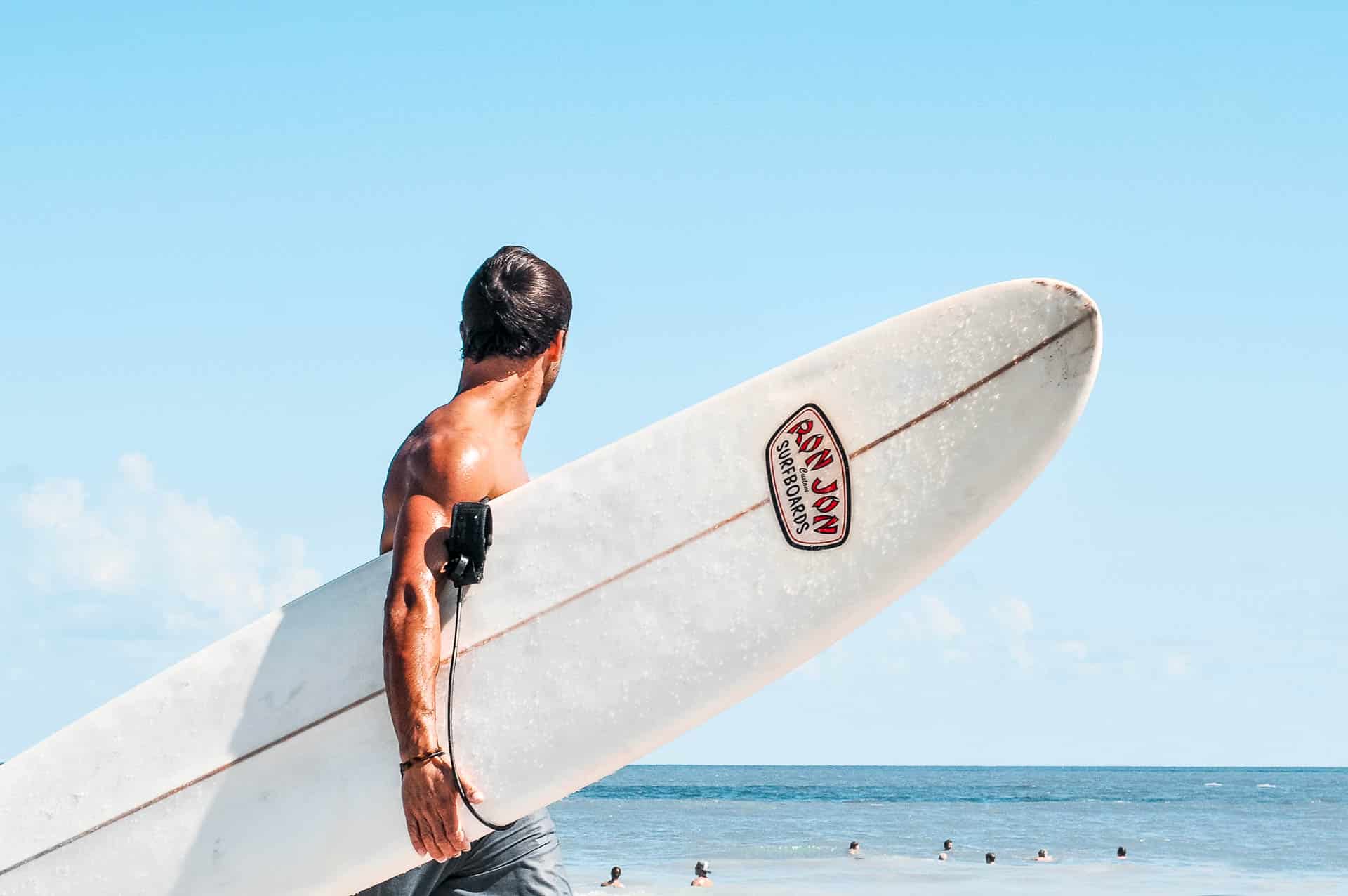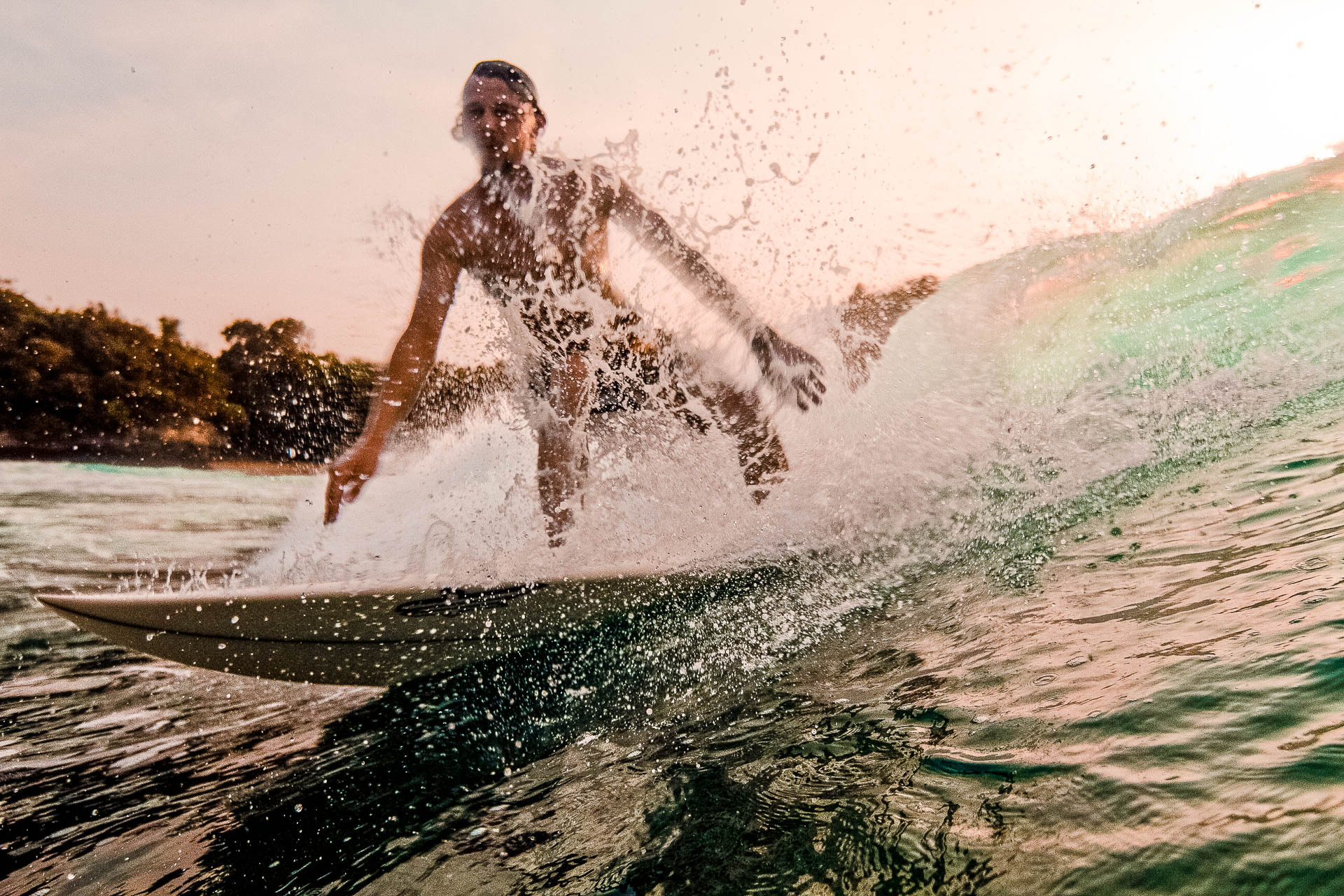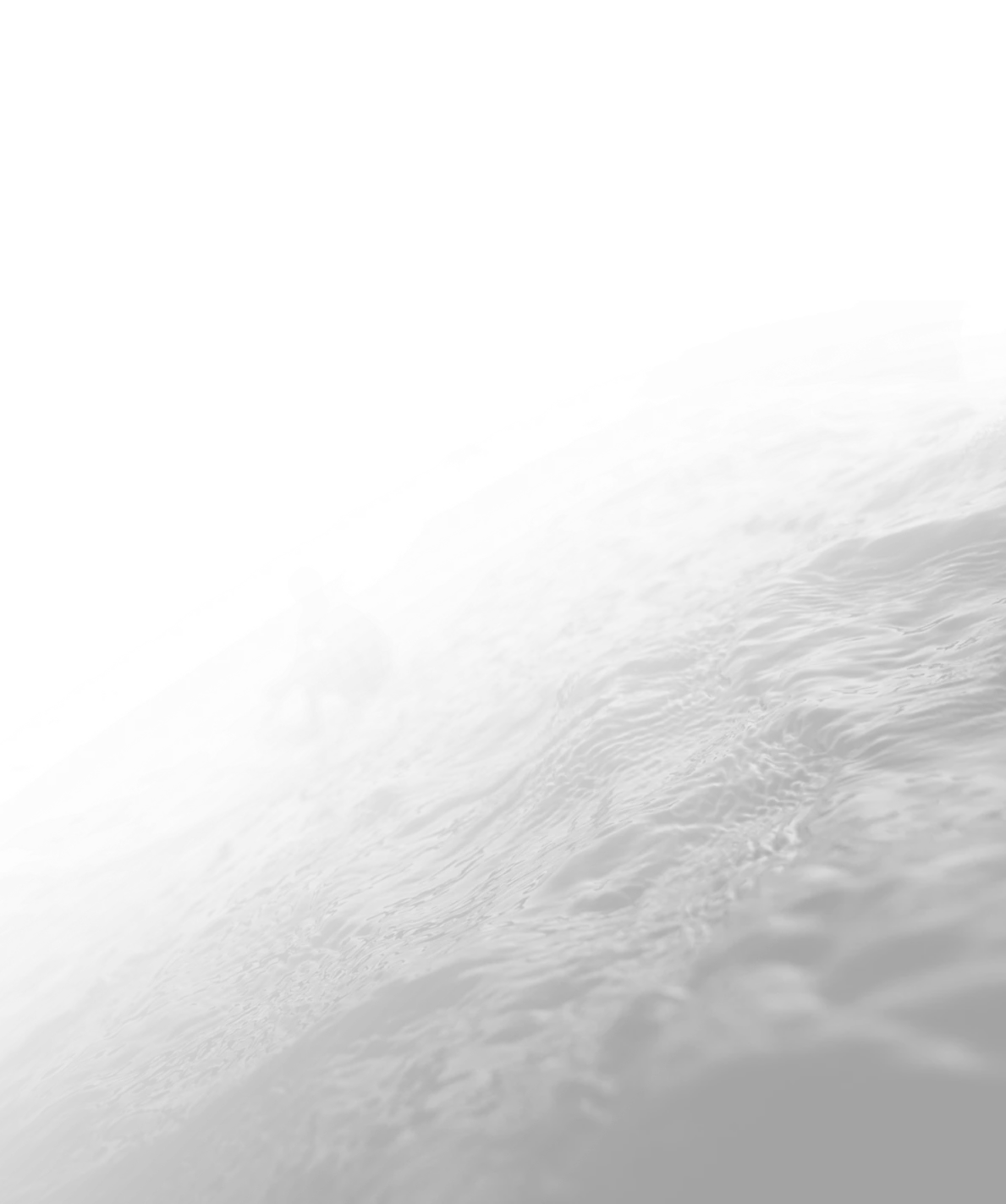Picture this – the thrill of riding waves, the rush of the ocean’s embrace—it’s what makes surfing an irresistible calling for thrill-seekers and water lovers alike. But hold on, there’s a whole other side to this exhilarating sport. It’s all about the behind-the-scenes magic—the nuts and bolts (well, figuratively speaking) that make up a surfboard’s core, the stuff that turns waves into an art form.
From the sleek curvature of the surfboard rails to the purposeful placement of the surfboard fin, every detail plays a pivotal role in creating the ultimate wave-riding experience. Join us on a journey of exploration as we dive into the depths of a surfboard’s anatomy, unraveling the mystery behind its various components and the profound impact they have on a surfer’s connection with the ocean.
1. Nose and Tail Shapes: Influencing Control and Maneuverability
The overall shape of a surfboard greatly affects its performance. The nose, located at the front of the board, and the tail, positioned at the back, come in different configurations, each serving a distinct purpose.
A pointed nose is often seen on boards designed for larger waves. This shape helps the board cut through the water and aids in stability when faced with powerful waves. On the other hand, rounded noses are more common on boards used for smaller waves, as they allow for quicker turns and easier manoeuvrability.
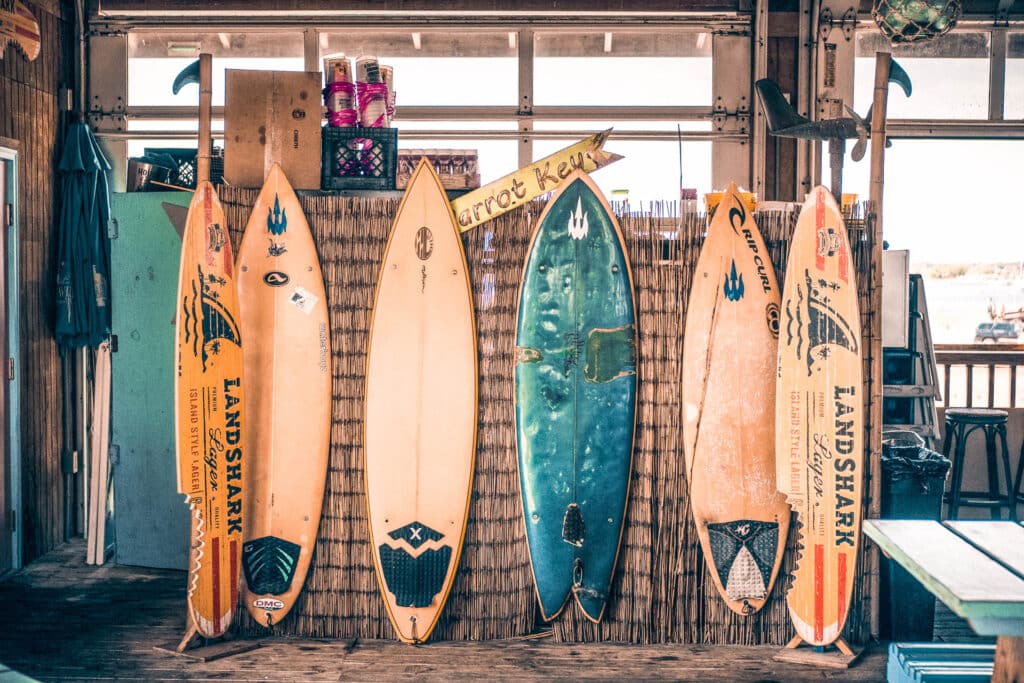
Tail shapes, too, play a crucial role. Pin tails are characterized by a narrow, pointed design that helps maintain control in bigger waves. In contrast, squash tails are wider and offer more stability, making them ideal for smaller waves and performance surfing. Swallow tails combine the benefits of both designs, providing control in larger waves and manoeuvrability in smaller conditions.
2. Rails: Finding the Right Edge
Rails, often referred to as the sides of the surfboard, wield a significant influence on the board’s performance and interaction with the water’s surface. Carrying distinct shapes and thicknesses, they are integral components that surfers carefully consider when choosing their boards.
These unassuming elements play a pivotal role in the ride, translating the surfer’s intentions into the dance with the waves. The variations in rail design lead to a range of effects, ensuring that surfboards are not only versatile but also tailored to specific surf conditions and skill levels.
In the realm of rail shapes, the dichotomy between soft and hard rails is particularly noteworthy. Soft rails feature rounded edges, akin to a gentle curve, imbuing the board with forgiveness and stability. These rails are especially suited for beginners and for navigating smaller waves where control and balance are paramount.
On the other end of the spectrum, hard rails possess sharper edges, allowing for precise and responsive control. This design choice caters to experienced surfers who seek to harness the wave’s energy for high-performance manoeuvrers.
The choice between these two rail types isn’t just about aesthetics—it’s a calculated decision that hinges on a surfer’s skill and the wave’s temperament.
3. Deck and Bottom Contours: Balancing Stability and Manoeuvrability
The deck of a surfboard refers to the top surface that the surfer stands on. A flat deck offers stability, making it easier to maintain balance and paddle efficiently. This is particularly useful for beginners and those riding smaller waves.
On the other hand, a domed deck can enhance the board’s manoeuvrability and responsiveness, allowing experienced surfers to execute advanced manoeuvres.
The bottom contours of a surfboard refer to the shape and features on the underside of the board.
Concave bottoms have a slight curve that helps channel water, providing lift and speed. This can be advantageous for faster and more dynamic turns.
Convex bottoms, on the other hand, have a reverse curve that disperses water, providing more stability and control.
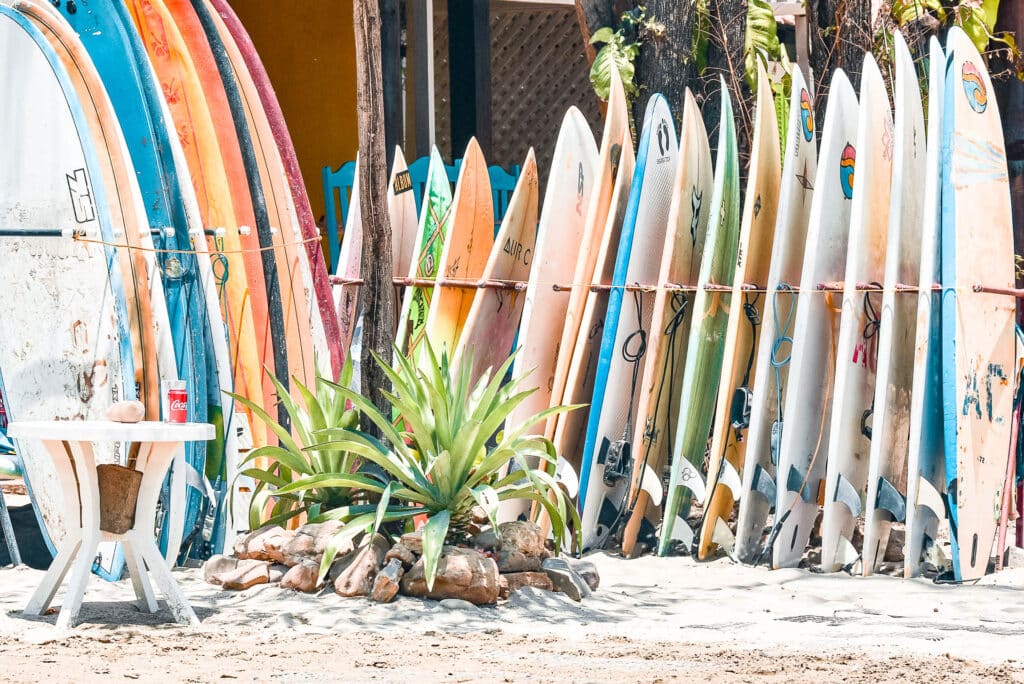
4. Surfboard Fin and Fin Plugs: Navigating the Waters
Surfboard fins are arguably one of the most important components when it comes to control and maneuverability. They attach to the bottom of the board and influence how the board reacts to the water’s flow.
Single fins were the original design, offering stability but limited maneuverability. However, modern designs incorporate multiple fin setups, such as twin fins, which enhance maneuverability, and thruster setups, which provide a balance of stability and control.
Fin plugs are the attachment points for fins on the board. These allow surfers to adjust the fin placement to fine-tune the board’s performance based on the conditions and their riding style. This adaptability is crucial for achieving optimal performance in various waves and skill levels.
5. Rocker: Shaping the Wave Riding Experience
In the realm of surfboard anatomy, the concept of “rocker” takes centre stage, shaping the board’s behaviour as it navigates the ever-changing contours of the waves.
Rocker, often described as the curvature extending from the board’s nose to its tail, is a crucial determinant of how a surfboard performs in varying wave conditions. This dynamic element stands as a testament to the marriage of form and function in surfboard design.
The nose rocker, or the curvature at the front of the board, is a pivotal factor in dictating a surfboard’s response to steep and critical waves. A higher nose rocker raises the nose of the board, preventing it from plunging into the water during daring drops and intense manoeuvres.
This design element is an ally of big-wave surfers, enabling them to take on towering waves with confidence. On the other end of the spectrum, a flatter rocker profile is a go-to for smaller waves. By minimizing the curvature, the board maximizes speed and stability, allowing surfers to harness the energy of gentler waves.
Tail rocker, the curvature at the back of the board, brings a different facet into play. It facilitates controlled turns and the maintenance of speed while riding the wave’s face, translating the surfer’s intentions into graceful arcs and thrilling manoeuvres.
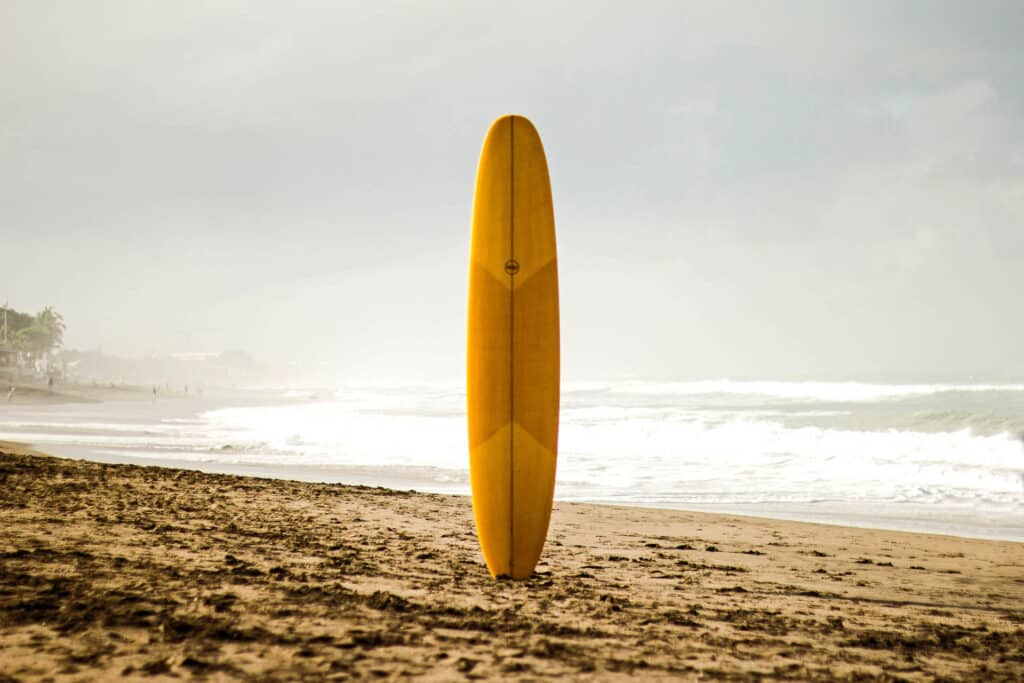
6. Traction Pad and Leash Plug: Ensuring Safety and Grip
The traction pad, often located on the back end of the board, provides surfers with grip and traction. It’s made from a textured material that helps keep the surfer’s back foot securely planted, enabling them to execute powerful maneuvers without slipping.
A leash plug is a small fixture near the tail of the board where the leash (also known as a leg rope) attaches. The leash tethers the surfer to the board, preventing it from drifting away in the waves. This not only ensures safety but also makes it easier for the surfer to retrieve their board after a wipe-out.
The Overall Outline and Design: Perfecting the Art of Riding Waves
The overall outline of a surfboard combines the various components discussed above to create a harmonious design that suits specific wave conditions and a surfer’s style.
Different types of surfboards, such as shortboards, longboards, fish boards, and tow-in boards, have distinct shapes tailored to different types of waves and desired performance outcomes.
The right combination of features results in a surfboard that maximizes a surfer’s ability to ride waves with finesse and grace.
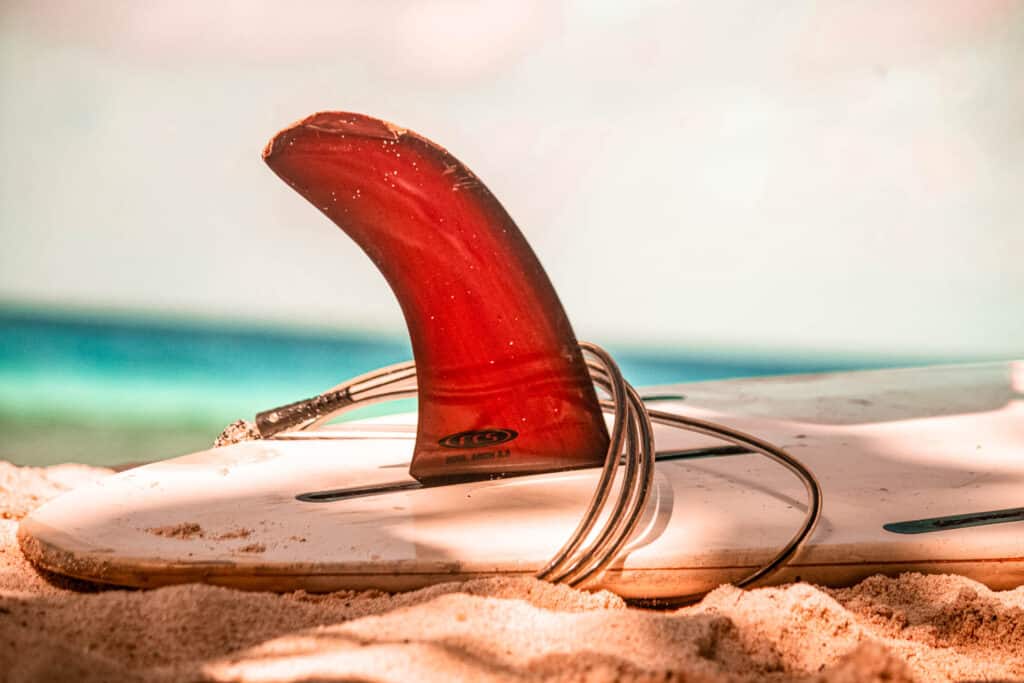
Best Boards Brands
When selecting a surfboard, it’s essential to consider factors such as your skill level, preferred wave conditions, and the type of surfing you want to pursue. These five brands stand out for their dedication to quality, innovation, and the ability to provide surfers with options that align with their individual preferences and needs.
- Channel Islands Surfboards: Channel Islands is a renowned brand that has been shaping surfboards for decades. Founded by legendary shaper Al Merrick, their boards are known for their high-quality craftsmanship, performance-driven designs, and innovative technologies.
- Firewire Surfboards: Firewire is known for its commitment to sustainability and innovative construction techniques. They utilize materials like eco-friendly EPS foam and bio-based resins, which not only reduce environmental impact but also contribute to enhanced performance.
- Lost Surfboards: Founded by visionary shaper Matt “Mayhem” Biolos, Lost Surfboards has gained a cult following for its diverse range of boards that cater to surfers seeking performance and progression.
- JS Industries: Founded by Australian shaper Jason Stevenson, JS Industries is renowned for crafting high-performance surfboards that cater to surfers of all levels. With a wide range of models designed for different wave types, JS boards are known for their speed, maneuverability, and attention to detail.
Rusty Surfboards: Rusty’s boards are known for their versatility and ability to excel in a variety of conditions. The brand’s commitment to innovation and adapting to the changing trends in surfing has led to the creation of boards that suit both traditional and progressive styles.
The intricate surfboard anatomy consists of multiple elements, each serving a specific purpose to enhance a surfer’s experience on the water. From the nose and tail shapes to the rails, fins, and bottom contours, every detail contributes to how the board interacts with the waves.
By comprehending the nuances of surfboard anatomy, surfers wield the power of informed choice. Selecting a board that harmonizes with their skill level, wave conditions, and desired style becomes an art in itself.
Embark on a surfing journey like never before with Rapture Surfcamps! Immerse yourself in the world of waves and discover the art of surfing with our expert instructors. Our camps not only provide hands-on training but also offer an in-depth exploration of various surfboard types.
At Rapture Surfcamps, we believe that understanding your surfboard is key to mastering the waves. Our experienced instructors will guide you through the nuances of different surfboard shapes, sizes, and materials, enhancing your overall surfing knowledge.
What sets us apart is our unique rental service, allowing you to experience the thrill of riding diverse surfboards without the commitment of purchasing. Test out various styles, find the perfect match for your skill level, and elevate your surfing experience with Rapture Surfcamps.
Join us and ride the waves with confidence as you gain insights into the world of surfboards. Book your surf adventure today!
Visit www.rapturecamps.com to book a stay at one of our surf camps today!
Hear What Our Guests Are Saying
FAQs
Surfboards have several key components, including the nose, tail, rails, deck, bottom, fins, leash plug, and traction pad.
The nose is the front part of the surfboard. It helps determine how the board paddles and how well it handles different wave conditions. A pointed nose is ideal for better maneuverability, while a rounder nose provides stability.
The tail shape influences the board’s turning ability and speed. A narrow, pointed tail is great for quick turns and responsiveness, while a wider tail provides stability and helps generate speed.
Rails are the edges of the surfboard. Their shape affects how the board interacts with the water. Thin, sharp rails are suitable for quick turns and responsiveness, while fuller, rounded rails offer stability and control.
The deck is the top surface of the surfboard. Its contour can affect stability and control. A domed deck provides more buoyancy, while a flatter deck offers better control and responsiveness.
The bottom contour, including features like concaves, channels, or V-shapes, influences how water flows beneath the board. These contours affect speed, lift, and maneuverability in different wave conditions.
Fins provide stability and control, helping the board maintain direction and execute turns. Different fin setups (single fin, thruster, quad) cater to various surfing styles and wave conditions.
A leash plug is a small, reinforced hole near the tail of the board where you attach the leash. The leash prevents the board from drifting away when you fall off, ensuring it stays nearby for a quick recovery.
A traction pad, often found on the rear deck of the board, provides grip for the surfer’s back foot. It enhances control and stability, especially during manoeuvres, and eliminates the need for wax in that area.
Consider factors like board size, volume, and shape. Longer and wider boards with more volume are typically more stable and suitable for beginners, while shorter and narrower boards are designed for more advanced surfers. Consulting with a knowledgeable surf shop or instructor can also help you find the right fit.
